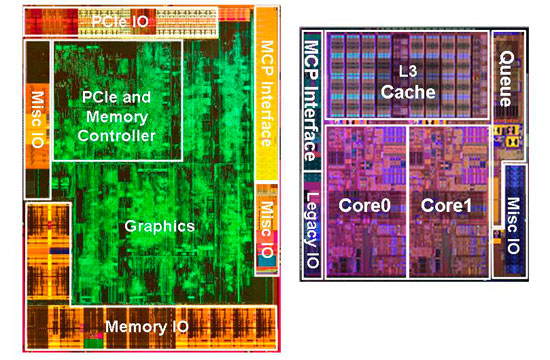Intel’s Core i5-655K & Core i7-875K: Overclocked and Analyzed
by Rajinder Gill on May 28, 2010 5:00 AM ESTBetter than our i3-540 for Overclocking?
Part of the attraction generated by the allure of unlocked multiplier processors is the additional flexibility purportedly provided, allowing any manner of clock domain frequency combinations. The obvious question has to be what an unlocked multiplier set offers the Clarkdale topology? The real ticket to retaining performance on this platform is to keep QPI frequency as close as possible to processor core frequency. That’s because the memory controller is off-die and the CPU communicates with the memory controller via the QPI link (the data link between the MCP stages in the images below).

Too wide a gap between both clock domains and the CPU must hold data for longer periods of time in the associated buffer stage before it can be transferred to the next bus. As a result, setting too high a CPU multiplier with too low a reference clock (BCLK) would neglect QPI bus frequency. This is because Intel limits the range of QPI multipliers at our disposal. What we want to use is a CPU core multiplier that is the same as or one notch higher than the QPI multiplier ratio.
Another thing that becomes readily apparent with the Clarkdale topology is that memory speeds around the DDR-3 1800 mark are generally the upper limit for most processors when absolute stability is required at reasonable voltage levels. Slightly higher speeds are possible but only by sacrificing valuable memory access latency – meaning you have to either run loose memory timings or drop QPI frequency to compensate. Given the choice, we’d sacrifice a little memory bandwidth before sacrificing a lot (lowering the QPI frequency). With this in mind, all of our comparisons have been made using the highest available QPI multiplier ratio on each processor, with the actual QPI frequency closely matched:











51 Comments
View All Comments
Rajinder Gill - Friday, May 28, 2010 - link
Hi,The actual "break point" is at 3.962GHz to be precise. A 9W step to 3.986GHz, followed by a 11w step to 4.009GHz. Anything higher than this and I'm loading up at 85C (according to DTS) and I can't get Linpack stable. I've extended x to show the 4.009GHz point. We'll endeavour to plot some more curves featuring some of the parts you mention if time allows.
Thanks!
Raja
Spenny2112 - Friday, May 28, 2010 - link
This only further confirms the change that the pc industry will be undergoing in the near future.Interitus - Friday, May 28, 2010 - link
Why does this make any sense on the 1156 platform? Intel created 2 different platforms, 1366 enthusiast and 1156 mainstream. Why is this on 1156 and not on 1366? Does that make any sense since 1366 is supposed to be the enthusiast/OC/hardcore version?Keep in mind I'm not arguing the viability of either socket. I'm just saying that Intel designed 1366 to be the high end, so why do this for the low end, but keep the unlocked chips for 1366 at $1k?
blandead - Friday, May 28, 2010 - link
1 reason that comes to mind first... $$$$$$2 this isn't targeted toward the enthusiast overclocker
the ones buying 1366 don't need unlocked multipliers to reach 4ghz or 1800+mhz ram speed.
I'm an AMD fanboy and my friend bought an i7 930 and 2000mhz ram and asked me to overclock it. I've never played with an i7 before, but surprisingly it was easy as cake to get it to 4.1ghz and 1850mhz ram on air and still have QPI overclocked past 6.4 dont quite remember i dont use the i7. Point is, with those achievements on a 930 I don't see a need for unlocked multiplier or k series.
TheBLK - Friday, May 28, 2010 - link
So why the messing BLK ????geokilla - Friday, May 28, 2010 - link
That's a huge jump in power consumption... But then these are engineering samples. I hope the retail ones will be better.Jamahl - Friday, May 28, 2010 - link
"This is another of those situations where we’ve had to make an eleventh-hour conference call with Intel to work out what and who these processors are aimed at."How about you make your own minds up instead?
First Anand did it with the awful clarkdale now you are doing it with these similarly awful cpu's. If intel gives you shit, TELL US ITS SHIT. Take a look around the web and see how poorly these cpu's were received elsewhere.
My respect for AT is at an all time low - there is no longer any pretence that you aren't an intel shill.
Hrel - Friday, May 28, 2010 - link
But it's about F***ing time!zodiacfml - Friday, May 28, 2010 - link
simply, the new unlocked chips does not offer real advantages compared to their siblings except for dynamic overclocking and the one posted which is little better turboboost speeds.yet, the additional cost compared to the performance of AMD's black edition processors is not that reasonable.
sergiu - Saturday, May 29, 2010 - link
It would have been nice if we could see the power consumption when dual cascade cooling has been used (both in stock and overclocking). I'm interested to see the leakage scalling with temperature!